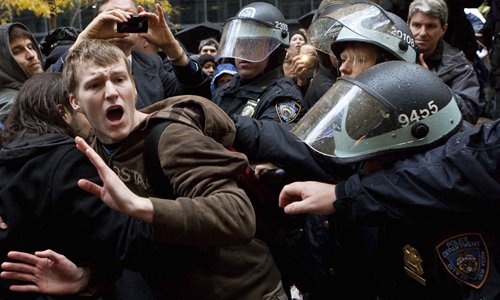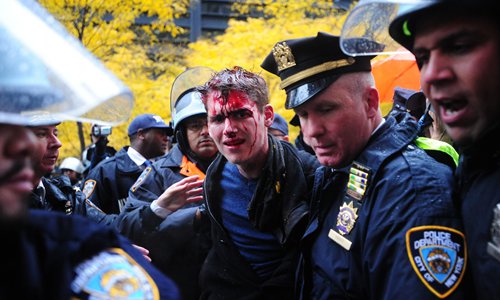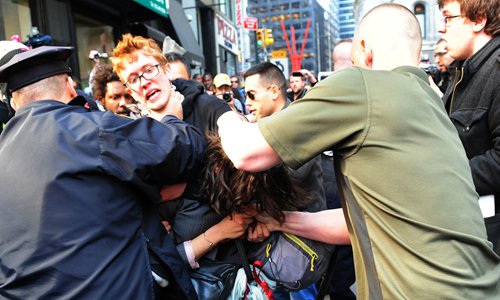Western response to HK police actions shows hypocrisy

On November 17, 2011, an Occupy Wall Street protester is grabbed by police as he tries to escape a scuffle in Zuccotti Park in New York. Photo: IC
The months of unrest and violence in Hong Kong have greatly affected the social order and dealt a blow to local tourism and catering businesses. Many people in Hong Kong sincerely hope that the violence can be stopped. An Occupy Wall Street protester is grabbed by police as he tries to attempt to shut down the New York Stock Exchange on November 17, 2011. Photo: IC
However, Hong Kong Police, who are expected to be the main force to stop violence and restore social order, have been subjected to groundless accusations from some media and politicians, especially those from the US.
No one knows better than the US that law enforcement from the police should be respected. Judging from previous reports, in the face of radical protesters, the US police have never been soft-hearted. Some people's remarks in the US about Hong Kong police reflect their hypocrisy and double standards.
Los Angeles riots
On March 3, 1991, Rodney Glen King, an African-American, was pulled over for speeding and drunken driving by police officers in Los Angeles. He was violently beaten by Los Angeles Police Department officers.
A civilian filmed the incident and sent the footage to a local news station. After distribution by mainstream media in the US, the incident attracted widespread attention.
The four police officers were tried on charges of use of excessive force. But on April 29, 1992, the jury, which consisted of nine white, one mixed white, a Latino American and an Asian American, returned a not guilty verdict.
The result enraged local black people and triggered the 1992 Los Angeles riots, which lasted six days and left 63 people dead and 2,373 injured, according to Los Angeles Times.
On May 1, the then president George Bush ordered 4,500 military troops into Los Angeles to help quell the violence. He also sent 1,000 riot-trained federal law officers to the city. He condemned the violence and called it "riots" in a public speech.
The government's intervention helped control the situation and social order in Los Angeles was quickly restored. More than 12,000 people were arrested. A total of 3,700 buildings were damaged and the property loss reached $1 billion.

Occupy Wall Street
The 2011 Occupy Wall Street was another "battle" between the US police and protesters. On September 17, many protesters gathered in Manhattan in New York with their tents in an attempt to turn Wall Street into Tahrir Square in Egypt.
The organizers claimed that the protests were aimed at the unfairness in US society, the conflicts between the Republican Party and the Democratic Party as well as the power-for-money deals in US politics. Later, similar movements, including "Occupy Chicago" "Occupy Los Angeles" took place in many parts of the US. The movement came to the capital, Washington DC in October 2011.
The Occupy Wall Street movement was always closely monitored by police in New York. Although some protesters were arrested for crossing road barricades or disturbing traffic, in general the police dealt with them softly.
The situation changed as the protests continued. Protesters' set up tents in Zuccotti Park and made it their base, which disturbed nearby residents' regular life and brought health and fire hazards.
The police decided to clear the site on the early morning of November 15. Thousands of police joined the action and surrounded the park. Riot squads with batons and tear gas entered the park to drive protesters out. The action lasted for three hours with some protesters who clashed with police being beaten and dragged out of the park.
The police arrested some 200 protesters who refused to cooperate and the Supreme Court in New York gave the police their backing. Similar moves in other parts of the US also took place.
The police action to clear Zuccotti Park was supported by the general public, and few media outlets in the US questioned their decision. Some UK media said that FBI had implied that the Occupy Wall Street movements constituted "terrorism" and they dealt with protesters as they would with terrorists. The US police, its national security departments and FBI cooperated thoroughly to break down this left-wing activity.

Plain clothes police and an uniformed officers clash with activists on Cedar Street near the World Trade Center Site resulting in arrests of activists on March 17,2012. Occupy Wall Street activists gather in Zuccotti Park in lower Manhattan to mark their sixth month anniversary. Photo:IC
Ferguson unrest
The Ferguson unrest was another severe race riot that involved protests which began a day after the fatal shooting of Michael Brown by police officer Darren Wilson on August 9, 2014.
Although a subsequent FBI investigation found that there was no evidence that Brown had his hands up in surrender or said "don't shoot" before he was shot, protesters believed that he had done so, and used the slogan "Hands up, don't shoot" in protest, US media reported.
On November 24, 2014, a grand jury decided not to indict Wilson, Fox News reported.
The verdict enraged local black people and triggered protests, which later grew into a series of riots with many setting fires and robbing shops. Local police sent riot squads and helicopters to deal with the riots and arrested at least 30 protesters on November 24.
The next day, police deployed tear gas against protesters gathered around a burning gasoline station. In the following days, conflicts between protesters and the police continued with the latter fighting back with tear gas, flash bombs and rubber bullets, with the assistance of SWAT.
The Ferguson protests had quite a follow-up impact on the US, highlighting many US social problems such as social fragmentation and racism. The Ferguson police also did well in handling violent and extreme actions, dispersing and arresting protesters regardless of their identities and occupations.
In attempting to quell the riots, some state senators were affected by tear gas and some got arrested for impeding traffic and defying police.
In August 2017, white supremacist groups (including alt-right, Neo-Nazis KKK and others) held a large scale rally in Charlottesville of Virginia, opposing the removal of the Confederate statues and monuments from the public venue. However, the rally descended into chaos when a car rushed into a crowd that was against the protesters, killing one and injuring 19.
The US Standard, a US news magazine, published an article that said the police kept contact with organizers and monitored social media to learn about the number of protesters and whether they were armed.
Although police equipment in the US has become militarized, US police still think they are not as good as their European counterpart in terms of strategies to handle violent threats. For example, the US police receive only a few months of training, while European police can spend several years in training.
The truth is that in order to make up for that shortcoming, the US police use guns to handle riots more often than other countries. Despite that fact, the police still feel powerless when violence meets with racial problems. In such cases, a military department known as the US Army National Guard will step in.
In the above-mentioned protest over race issues in Los Angeles, the Californian governor requested help from the National Guard, which was also seen in the Ferguson incident.
No tolerance
Similar to the US, the European countries also used various methods ranging from reinforcing equipment to using military force to secure police's core position in law enforcement targeting all kinds of large scale violent protests and rallies.
In April 2009, serious street riots broke out in the UK when the G20 Summit was held in London. The UK authority handled the situation according to the law without any compromise when facing various demands of the protesters. In addition to batons, the police also dispatched horseback police and helicopters to disperse protesters. Local media including the BBC also said that "robbery is an attack on common people."
In July 2017, masked protesters burned vehicles in the street during the G20 Summit in Hamburg, Germany. They also smashed and robbed stores, threw stones at the police, attacked a police station and shot signal detonators at a police helicopter. According to data released by the German police, a total of 476 police were injured in the chaos.
During the riot, German police dispatched as many as 15,000 police officers to maintain order, and arrested more than 400 rioters. A 21-year-old Dutch man was sentenced to two years and seven months prison for throwing two bottles at the police. Some said that the sentence was excessive. The judge responded that the sentence was in accordance with the law that stated actions against police should be heavily punished.
After the rally in Hamburg, Yougov, a polling organization, carried out a survey in Germany. The result showed that more than half of the interviewees support the authorities in imposing maximum control over illegal gatherings for the purpose of preventing violence.
France adopted targeted measures against the Yellow Vests movements which started in November 2018. At the beginning of 2019, France issued a law to forbid masked rallies and allow police to carry out body and car searches in places around the rally venues to crack down on violent protests and deter possible violence. However, in the Yellow Vests movement, with the rise of violence, the intensity of law enforcement of the French police also increased, and it was quite frequent for protesters to get injured. The French police also took some credit in quelling the movement.
Global Times - Agencies
Newspaper headline: Keeping the peace